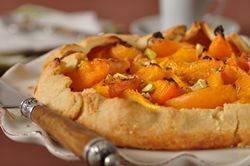|
|
| Subscribe Now |

|
|
Short Crust Pastry:
1 1/4 cups (175 grams) all-purpose flour
1/2 teaspoon (2 grams) salt
1 tablespoon (14 grams) granulated white sugar
1/2 cup (1 stick) (113 grams) unsalted butter, chilled, and cut into 1 inch (2.5 cm) pieces
1/8 to 1/4 cup (30 - 60 ml) ice water
Apricot Filling:
1 1/2 pounds (680 grams) fresh ripe apricots (8 large or 14 small apricots)
1/3 - 1/2 cup (65 - 100 grams) granulated white sugar (or to taste)
1/8 teaspoon kosher salt
Garnish:
1/4 cup (25 grams) chopped pistachios or almonds
|
|
Short Crust Pastry: In a food processor, place the flour, salt, and sugar and process until combined. Add the butter and process until the mixture resembles coarse meal (about 15 seconds). Pour 1/8 cup (30 ml) water in a slow, steady stream through the feed tube until the pastry just holds together when pinched. Add remaining water, if necessary. Do not process more than about 30 seconds.
Turn the pastry out onto your work surface, gather it into a ball, cover with plastic wrap, and refrigerate for about one hour to chill the butter and allow the gluten in the flour to relax.
Once the pastry has chilled, remove from refrigerator and place on a lightly floured surface. Roll the pastry into a 13 inch (32 cm) square. To prevent the pastry from sticking to the counter and to ensure uniform thickness, keep lifting up and turning the pastry a quarter turn as you roll (always roll from the center of the pastry outwards to get uniform thickness). Transfer the pastry to a parchment paper lined baking sheet. Cover and place in the refrigerator while you prepare the apricots.
Apricot Filling: Wash the apricots. Cut the apricots following the suture from stem to blossom end and then up the opposite side. Gently twist the two halves of the apricot and it should easily separate. Remove the seed and cut each half into two or three wedges (depending on size). Place the wedges of apricots in a large bowl and season with a pinch of salt. Then add the granulated white sugar and toss gently to combine. Arrange the apricot wedges evenly on the pastry (cut side up), leaving about a two inch (5 cm) wide border. Scrape any remaining sugar from the bowl and sprinkle over the apricots. Gently fold the edges of the pastry up and over the apricots, pleating as necessary. Make sure to seal any cracks in the pastry.
Bake the tart in a preheated 405 degree F (205 degree C) oven for about 35 - 45 minutes or until the pastry is golden brown. Remove from oven and place on a wire rack to cool. Garnish with chopped pistachios or almonds. Best served warm, with vanilla ice cream.
Makes one - 11 inch (26 cm) tart.
|
|
This European-style Apricot Tart shows how good perfectly ripened apricots can taste. Fresh apricots are such a treat so when we use them in our baking we want a dessert that brings out their sweet and acidic flavor. I believe this tart does just that. It takes fresh apricots, with their skins still intact, cuts them into thick wedges, gently tosses them with sugar and a little salt, and arranges them on a platform of buttery crisp pastry. I love how this tart looks after it is baked, the golden brown pastry and the apricot wedges with their caramelized tips. Very nice warm from the oven served with a small scoop of vanilla ice cream.
The pastry used for this apricot tart is made from a mixture of flour, a little sugar, salt, butter, and ice water. It has a high ratio of fat to flour which gives the pastry its crisp and crumbly texture and buttery flavor. No tart or pie pan is needed here, for this is what we call a free form tart. That means the pastry is rolled out, the fruit is arranged on top, and then the edges of the pastry are folded up and over the fruit. It is the perfect backdrop for fresh fruit at its prime. I have used the same technique for this Peach Tart, and this Raspberry Tart. The secret to its success is to bake it in a hot oven so that the pastry bakes and browns quickly and the fruit softens, yet still retains its shape.
It doesn't seem that long ago that we had to content ourselves with dried apricots as fresh were almost impossible to find, unless you were fortunate enough to live near an orchard. This lovely orange colored stone fruit is native to China but it eventually made its way to California where most of this fruit is now grown. When you look at an apricot you can see its resemblance to the peach. Its has that same round shape, albeit smaller, and fuzzy outer skin which some like to remove, but I don't, especially for this tart. Both of these fruits also have that characteristic "suture" that runs from stem to blossom end, which serves as a guide for cutting the fruit in half to remove its inner seed. And let us not forget the apricot's flesh, sweet and juicy with a touch of tanginess that never fails to delight. When buying apricots, smell and feel each piece of fruit. They should smell of apricots and feel firm, yet have a slight give when you press gently on its shoulders. Make sure there are no bruises, cuts, or soft patches on the apricots.